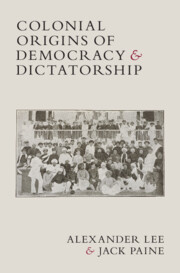Book contents
- Frontmatter
- Contents
- Figures
- Tables
- Acknowledgments
- 1 Introduction
- 2 A Theory of Colonial Electoral Institutions
- 3 Representation in Settler Colonies through 1850
- 4 Imperial Expansion and Restrictive Elections: 1850–1945
- 5 Mass Franchise Expansion after 1945
- 6 Postcolonial Persistence
- 7 Conclusion
- Appendix: Data and Regression Analysis
- References
- Index
4 - Imperial Expansion and Restrictive Elections: 1850–1945
Published online by Cambridge University Press: 08 May 2024
- Frontmatter
- Contents
- Figures
- Tables
- Acknowledgments
- 1 Introduction
- 2 A Theory of Colonial Electoral Institutions
- 3 Representation in Settler Colonies through 1850
- 4 Imperial Expansion and Restrictive Elections: 1850–1945
- 5 Mass Franchise Expansion after 1945
- 6 Postcolonial Persistence
- 7 Conclusion
- Appendix: Data and Regression Analysis
- References
- Index
Summary
Amid imperial expansion in the nineteenth and early twentieth centuries, white settlers were a tiny minority in most newer colonies, and in some cases, a non-white middle class arose that was educated in the colonizer's language and political system. This produced three main outcomes. (1) White settlers became a sizable minority in certain parts of Africa, which yielded electoral representation. Settler-minority regimes strongly opposed political rights for non-whites. (2) Settlers reversed their support for electoral institutions when their dominance was threatened. In the British West Indies in the mid-nineteenth century, white planters responded to the prospect of political control by Black politicians by disbanding their elected legislatures and accepting direct British Crown rule. (3) In some colonies with few settlers, a non-white middle class educated in the colonizer's language emerged. These elites were especially strong in the major port cities in South Asia and West Africa, and in colonies with emancipated slaves. Non-white elites in these areas gained representation by the 1920s, although with limited autonomy and a narrow franchise.
Keywords
- Type
- Chapter
- Information
- Colonial Origins of Democracy and Dictatorship , pp. 90 - 127Publisher: Cambridge University PressPrint publication year: 2024



